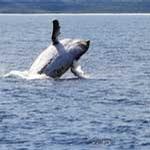
Cheapflights travels Australia's Humpback Highway
8 September 2015, 12:45PM
Infront Communications
They call it the Humpback Highway. Each year, between June and November, more than 17,000 humpback whales make their annual migration up the east coast of Australia.
The whales head north from Antarctica up to calve in the warm waters of the Whitsunday Islands between July and August and then use the journey home for the baby calves to learn life-skills required to survive in the cooler waters of Antarctica.
The travel experts at Cheapflights.com.au had a whale of a time, research the top spots along the Australian Eastern seaboard to see these gentle giants of the ocean.
The humpbacks complete the longest migration of all whales, covering more than 10,000km (5000km each way) and an average swimming speed of two knots per hour on their way north and a cruising speed of up to five knots on the homeward stretch, there’s plenty of places for whale watching.
Bruny Island, Tasmania
A short drive from Hobart will take you to Adventure Bay where the whales regularly stop to take shelter. The best time for whale watching here is between May and July on their journey north and then again between September and December when the whales are on the last leg of their passage home to Antarctica.
(1).jpg)
Photo courtesy of Infront Communications
Great Ocean Road, Victoria
The Humpback Whale travels in close proximity to the coastline and are often seen along the Great Ocean Road on their migration north between late April and early May but more regularly sighted on their return journey from late July to mid-August. A whale watching lookout platform has been constructed at Logan’s Beach in Warrnambool, which is around three hours from Melbourne along one of Australia’s most spectacular drives along the Great Ocean Road.
(1).jpg)
Photo courtesy of Infront Communications
Sydney Harbour Heads, New South Wales
Just a short cruise out of Sydney Harbour is were whale watchers will see the Humpbacks make their way up and down the coastline between May and November. It’s not uncommon for the whales to make their way into Sydney Harbour for a spot of sightseeing – causing all sorts of havoc with the re-diversion of scheduled ferries to keep a safe distance from the 40-tonne visitor.
.jpg)
Photo courtesy of Infront Communications
Port Stephens, New South Wales
Scenic Port Stephens on the central coast of New South Wales is famous for being home to more than 140 bottlenose dolphins who call they bay home. It’s also a great place to watch the magnificent northern migration between June and August and their return from September to November.
-720px.jpg)
Photo courtesy of Infront Communications
Byron Bay, New South Wales
Australia’s most easterly point is a great spot to watch the whales cruise by. The best vantage point is from the iconic Byron Bay Lighthouse.
(1).jpg)
Photo courtesy of Infront Communications
Gold Coast, Queensland
With 42km of beaches, the Gold Coast is a popular place to watch the migration either from land or by boat. One of the more unique places to look out for the Humpbacks is from SkyPoint Observation Deck, Australia’s only beachside observation deck on the top of one of Australia’s tallest buildings, Q1.
(1).jpg)
Photo courtesy of Infront Communications
Hervey Bay, Queensland
Hervey Bay on Queensland’s Fraser Coast is the whale watching capital of Australia. Each year around 7000 humpback whales stop in the calm sheltered waters of the bay and whale watchers can expect a different experience depending on the time of the season they visit. The first sightings are usually in June and July with male adults putting on tail-slapping routines to attract females. In August and September, it is more common to see young calves with their mothers while in October the calves have learnt their lessons of survival from their mothers and are active with breaches and tail slaps as they prepare for their southern migration.
-720px.jpg)
Photo courtesy of Infront Communications
Whitsunday Islands, Queensland
The calm, warm waters around the 74 Islands of the Great Barrier Reef turn into humpback birthing suites with pregnant mums arriving from July and then heading south by September. The most active time to see humpbacks in the Whitsundays is from mid to late August.
(1).jpg)
Photo courtesy of Infront Communications
Cheapflights.com.au a travel search comparison services that searches thousands of flights offerings for airline and travel agents sites, worldwide. It's completely free to use with no fees or charges and guests have the peace of mind knowing they are booking direct with the airline or travel agent.
